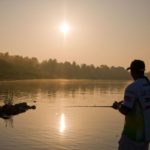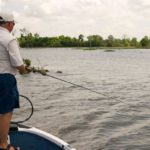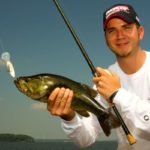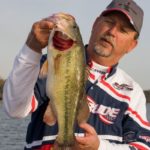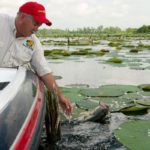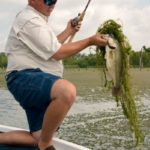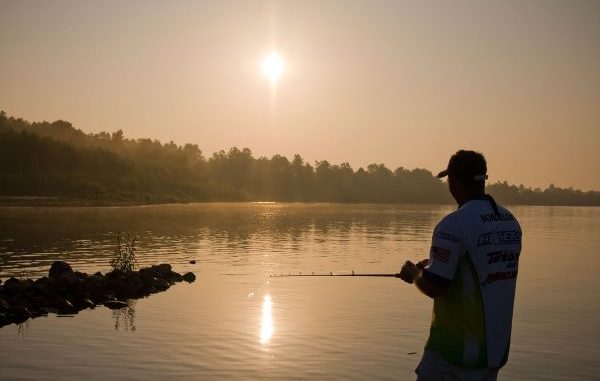
If you haven’t fished the Red River in a few years, you’re in for a shock from all the changes that have occurred. But one of the changes — a crop of big bass — is a boon for anglers.
The Red River might not be as bad as the old gray mare, but she definitely ain’t what she used to be.
Clark’s Marina is closed.
Standing timber has fallen.
Sixteen-foot holes have silted in to 6 inches.
If change is inevitable, the Red River has sure seen its fair share of it.
Depending on how frequently you fish the river, all this change might not be a bad thing.
If you haven’t fished it in a while, the fallen timber and siltation presents a challenge in finding fish and a danger in running your boat.
If you fish it every weekend, then you’ve evolved with the river and are probably wondering what all the fuss is about.
Experience goes a long way in figuring out how to catch bass on the Red River right now.
In other words, anglers who know where all the old holes are, which ones haven’t silted in, and which ones muddy the quickest don’t need all the visual references that the Red River once used to provide.
Head out there thinking the willows still define the old ditch where you busted them 10 years ago, and you’re going to be sadly disappointed.
That ditch is probably still there, but finding it without the aid of the timber that used to line its edges is going to be difficult.
And those rock jetties you used to burn with a crankbait? They’re still there, but good luck running a crankbait through the dirt.
“For me,” said long-time Red River guide Russ McVey (318-464-2277), “the biggest change over the last six to eight years has been the physical makeup of the river in the siltation and loss of standing timber.
“People like me who have been fishing it so long kind of know where the ditches and drains are, but somebody coming out fresh, it’s more difficult to find the edges you need to be on.”
Although much of the timber has turned into stumps, McVey said that just because you can no longer see the wood cover above water doesn’t mean it isn’t still down there under water.
“Really, the part of the tree that was out of the water didn’t hold fish anyway,” McVey joked. “So you’ve still got all that good stuff underwater that makes good cover for fish.
“As far as I’m concerned, those fish never knew there was a top to their favorite tree anyways.”
Bass may not have ever cared about the tops of the trees, but bass anglers relied heavily on them to point the way to the underwater contour changes.
According to Simsboro tournament angler Sid Havard, a 20-yard void in solid timber that twisted and winded was a no-brainer way to find the underwater ditches and depressions that stack up with bass.
“It’s a visual thing,” he insisted. “Where that void was obviously a creek channel a few years ago, now the lack of things to help you identify deep water will make you struggle if you don’t know where these spots are.”
Havard went on to explain that now anglers can be sitting right on top of a ditch and not even know it because there is nothing but water-level stumps where there used to be timber.
“The channel might be 20 yards farther over and you’ll never know it if you don’t accidentally stumble upon it,” he said.
Besides using standing timber to spot creek channels like Havard used to, McVey used standing timber to help him home in on the kind of bottom he wanted to fish.
“There used to be three kinds of timber on the river that you could look for to help you find fish,” McVey noted. “If I knew bass were on the spawning flats during spring, I just looked for the cottonwoods and underbrush that grew on the flats. If I was looking for the edge of drop-offs, I looked for the willows growing right on the edges.”
The other main change in the Red River is erosion and deposition, which has played a major role in changing the landscape of some of the most-popular fishing areas on the entire river system.
“A lot of places have sanded in from the high water the last couple of years,” Havard explained. “Once the river got over the rocks, it put sand in places where there was never sand before. And there are actually places you used to get into easily you can’t even go to anymore.”
McVey pointed out two spots that have silted in that not only would they surprise someone who hasn’t been on the river in a while, they pose a serious danger to boaters running the same places they used to run.
“One is right there where the old Clark’s Marina used to be,” McVey said. “There is a hole in the rocks where we used to run out to the river that you could cut through to get to Bulldozer Point. Right there on both sides it has silted in so much that it’s only 6 or 8 inches deep now.”
Another area is right across the river through the cut that leads into Caspiana. Used to, boaters entered the cut and ran upriver on the inside of the rocks before turning back into the timber.
“Some of those rocks shifted about two thirds the way up, and that allows current to blow through there,” McVey said. “That whole lane silted in from the rocks to the timber because of that.
“It used to be 15 feet deep; now it’s 6 inches.”
Although the area was dredged to create a little bit of a boat run, McVey cautioned that you could get in some serious trouble and maybe even get land-locked if you don’t know exactly where it is.
“And nothing is officially marked,” Havard put in. “Maybe a beer can here and a Clorox bottle there. Even though I used to guide on the Red River every weekend, I’m not comfortable running there anymore.
“Getting into the spot now entails getting off one stump only to get stuck on another.”
Most of the physical changes in the Red River are more of an inconvenience to getting around rather than an inconvenience to catching fish.
However, there is one physical change that has become a boon to bass anglers.
“Grass,” McVey pointed out. “Ten years ago, we didn’t have a lot of grass. What we had was minimal, and it hardly held any bass because they related more to the timber and contour changes than they did the grass.”
Now the river has lots of vegetation like water hyacinths, milfoil and hydrilla. And unlike 10 years ago, this greenery holds bass today.
McVey likened it to a can’t-take-the-country-out-of-the-boy mentality.
“I believe bass related to the timber so much back then because that was where they were spawned and hatched,” he explained. “They probably didn’t even know the shallow grass existed. But now we’ve got a class of fish that have been spawned and hatched in the grass over the last six to eight years.
“Since they grew up around that grass, that’s where they tend to spend most of their time.”
And even though Texas-rigged soft plastics still dominate much of the Red River bass fishing, McVey added that the physical change in timber has opened up some areas for a wider variety of baits than what he used to use.
“Good luck pulling a crankbait or a Rouge through the timber back then,” he continued. “You would have constantly stayed hung up. Now, with the timber falling out, it’s easier to run crankbaits without losing them. And rather than having to throw a Fluke all the time, we can now throw Rouges out there fairly easily.”
Moving around in the timber is also not as brutal on your boat as it used to be. While your trolling motor and big motor might take a beating, Red River regulars no longer have the racing-stripe scratches on the sides of their boats that used to give away where they spent most of their time fishing.
McVey and Havard have seen lots of changes take place to the Red River the last few years, but one final change they have noticed that keeps them coming back is the quality of the bass that live there now.
“I catch bigger fish on the river than I used to,” Havard noted, “but it’s definitely not the easy fishing it used to be.
“You’ve got to know what you’re doing to go out there and catch them today.”
McVey concurred and added that he has noticed the total number of 8-pound fish slowly creeping up over time.
“There are a lot of 2- to 3-pound fish and numerous 4-pounders,” he said, “but we’re seeing more and more fish over 8 pounds. Used to, an 8-pound fish was unheard of. Then we started seeing maybe one or two a year. Now it’s more like three or four a year.”
Overall the Red River is still a very good fishery with an abundance of bass that have grown smarter as the physical makeup of the river in which they live has changed around them.
The Red River definitely ain’t what she used to be. Sure, she may have a few more wrinkles here and sagging body parts there, but she’s still the same inside as she used to be.
Maybe she’s even getting better with age.
